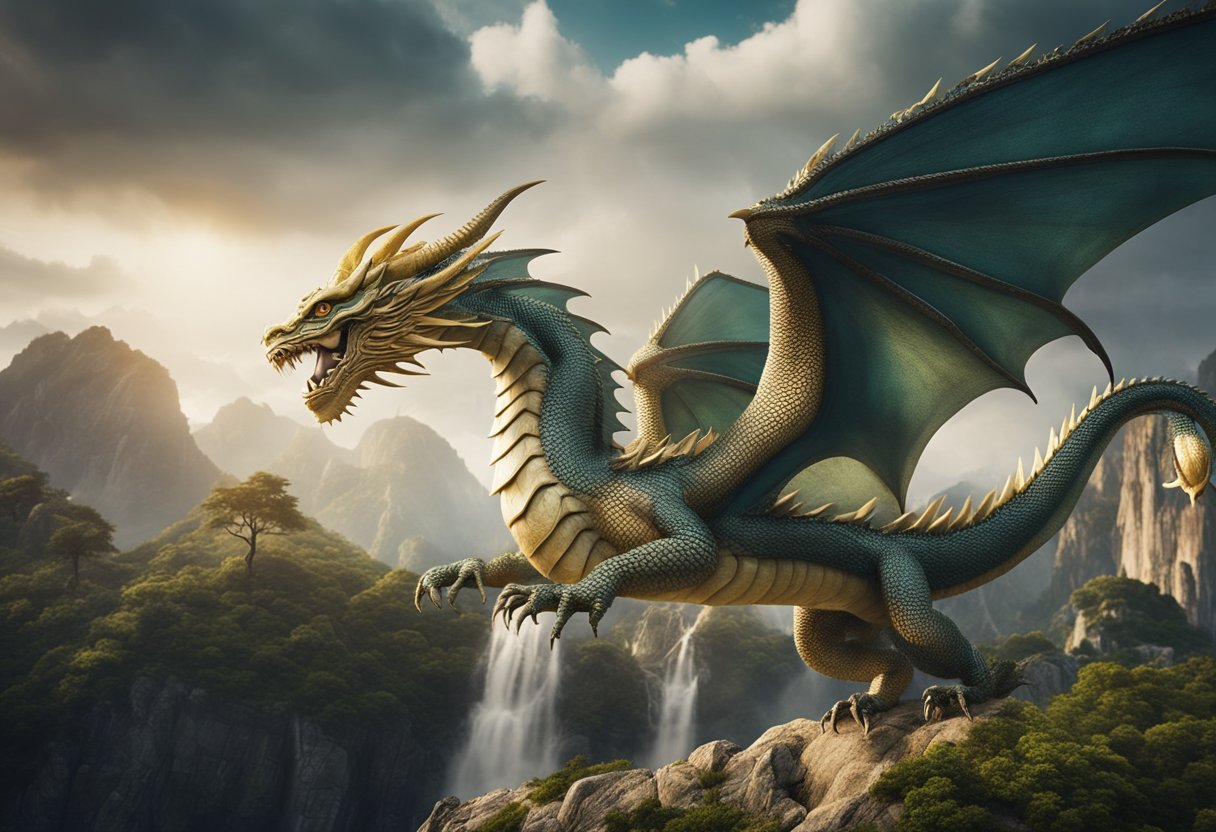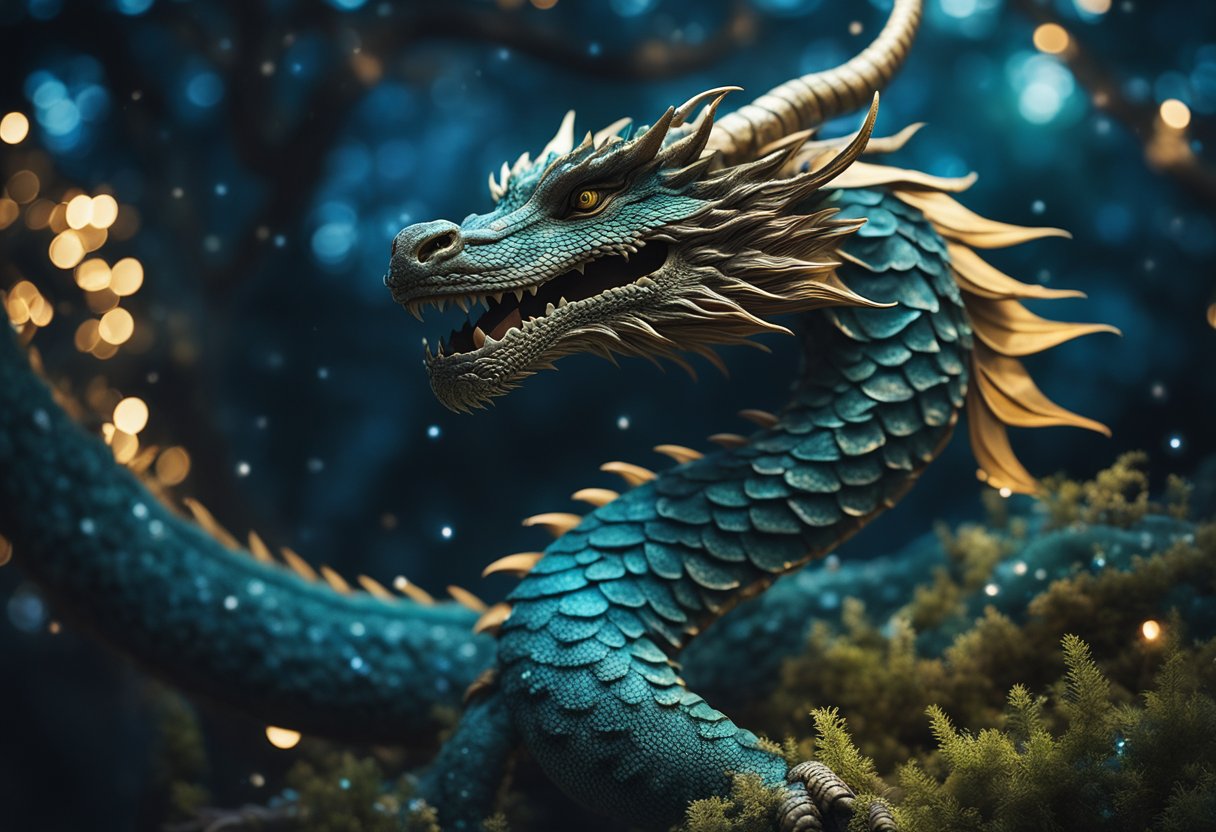The Cultural Significance of Dragons Across the World: A Global Perspective

Updated On: April 29, 2024 by Raghda Elsabbagh
Dragons have long captivated human imagination, appearing in mythologies and folklore across numerous cultures around the world. While most commonly recognised as mythical reptilian creatures, their representation and symbolism can vary substantially from one culture to another. In Asian traditions, dragons often embody auspicious power, wisdom, and prosperity and are deeply woven into the fabric of cultural belief and practice. For instance, dragons hold a vital place in the Chinese zodiac as symbols of strength and benevolence.

Conversely, in Western folklore, dragons have traditionally assumed a different role. They frequently emerge as adversaries to be overcome, representing chaos and malevolence. Knights in pursuit of honour might slay dragons to signify triumph over tyranny or evil. Despite these regional differences, dragons universally serve as powerful symbols in art, literature, and popular culture—even today, as modern interpretations of dragons continue to thrive in films, books, and other forms of media, reflecting age-old mythos in contemporary contexts.
Table of Contents
Mythological Origins of Dragons
Dragons have captivated human imagination for millennia, featuring prominently in the mythologies of various cultures around the world. These legendary creatures often embody the concepts of power, chaos, and creation.
Ancient Mesopotamia and Tiamat
In the Babylonian epic Enuma Elish, the dragon goddess Tiamat is a symbol of primordial chaos. According to these myths, she is the mother of all gods and engaged in a colossal battle with her offspring, who eventually defeat her. Her divided body then creates the heavens and the earth, linking dragons to the very fabric of the world’s creation.
Greek Tales and Typhon
Greek mythology tells of Typhon, a fearsome serpent-like monster that challenged the Olympian gods. Born from Gaia and Tartarus, Typhon embodies the forces of destruction and volcanoes. His battles with Zeus in legends depict a classic struggle between order, as represented by the king of the gods, and disorder.
Norse Sagas and Jörmungandr
Norse legends describe Jörmungandr (the Midgard Serpent) as an immense dragon that encircles the world, biting its own tail. It is said that when Jörmungandr releases its tail, Ragnarök will begin. This serpent-dragon stands as a potent archetype of Norse mythology, representing the cyclical nature of the cosmos.
The Cultural Significance of Dragons in Asian Traditions
In Asian cultures, dragons are not merely mythical creatures; they are potent symbols deeply woven into the fabric of society, representing strength, wisdom, and the natural world.
Chinese Dragon Symbolism
In China, the dragon, or long, stands as a powerful emblem of prosperity, strength, and good fortune. Historically associated with emperors and central authority, the dragon pervades various aspects of Chinese culture, even the Chinese zodiac, where it signifies auspiciousness. Unlike their Western counterparts, Chinese dragons are commonly depicted without wings but are still capable of flight, illustrating the high esteem in which these creatures are held.
Rain and Dragons in Japanese Culture
Japanese dragons, deeply influenced by Chinese lore, are also revered, often associated with rain and water bodies, signifying their crucial role in agriculture. These dragons are traditionally seen as water deities, controlling the vital element that ensures the prosperity of crops. Their significance highlights the ingrained appreciation of nature in Japanese cultural values.
The Vietnamese Dragon and Cultural Identity
The Vietnamese dragon represents a unique blend of indigenous and outside influences, encompassing traits of Chinese dragons while also embodying the spirit of Vietnam. Seen as a symbol of life, vigour, and the monarchy’s power in the past, the dragon is a profound expression of Vietnamese cultural identity. It conveys a historical narrative that remains relevant, linked to the fluid and harmonious relationship between ancestors and the natural environment.
The Role of Dragons in Western Folklore

Dragons have woven a complex tapestry through Western folklore, embodying a multitude of roles across various narratives. They appear as embodiments of evil or greed, adversaries of saints and heroes, and are sometimes symbolic representations of devils or ungodly forces within Christianity.
European Dragon Myths
European dragon myths predominantly cast these creatures as malevolent forces. A common narrative features them as guardians of vast treasures, a clear metaphor for greed. Due to their fearsome and powerful nature, dragons in folklore were often the ultimate challenge for a hero to overcome. The tale of “Saint George and the Dragon” epitomises this, where a lone knight triumphs over the beast, thus saving a kingdom and symbolising the victory of good over evil.
Dragons in Christianity’s Teachings
In Christianity, dragons take on a more spiritual interpretation. They are often equated with the devil and the idea of sin. The biblical Book of Revelation, for instance, refers to Satan as a “great dragon”, solidifying their evil connotation in Christian teachings. It’s through stories and teachings like these that dragons became entrenched as symbols of all that’s corrupt and a counterpoint to Christian virtue.
Modern Literature Dragon Interpretations
Modern literature has pursued a nuanced take on dragons. While past folklore often depicted dragons as embodiments of evil, contemporary stories sometimes reimagine them as complex beings. From the sinister Smaug in J.R.R. Tolkien’s The Hobbit — a throwback to traditional myths — to the benevolent and wise dragons found in some modern fantasies, dragons in literature have evolved to match our changing views on these mythical creatures.
Dragons as a Symbol of Power and Royalty
In various cultures, dragons epitomise the zenith of power and royalty. These mythical creatures are indelibly linked to emperors and rulers, often symbolising their authority and the prosperity they bring to their lands.
Emperors and Dragons in China
In China, the dragon stands as a potent emblem of imperial power and divine authority. Historically, Chinese emperors embraced the dragon as their personal symbol, reinforcing the belief that they were celestial descendants. The dragon’s imagery would often be adorned on royal garments and palaces, a practice evoking the creature’s association with success and prosperity. Significant relics of this can be traced back, as found in a tomb in 1987, revealing an ancient depiction of the loong (dragon) intertwined with the existence of early Chinese rulers.
Dragons and Norse Leadership
Within Norse mythology, dragons similarly held a significant place, connected to strength and leadership. In these sagas, dragons were often depicted as fierce protectors or colossal adversaries, their immense power analogous to that of commanding Norse leaders. Dragon imagery was commonly used on the prows of Viking ships, intended to channel the creature’s indomitable might and to convey a message of the chieftain’s dominance as they set out to conquer the seas.
The Dragon’s Representation of Nature and the Cosmos

Dragons have long been powerful symbols connecting the primal forces of nature and the expansive universe. They serve as potent embodiments of the natural world and its phenomena, as well as celestial entities overseeing the cosmos.
Dragons and Natural Elements
In various cultures, dragons are deeply intertwined with elemental forces. They are often seen as guardians of precious natural resources. In Chinese mythology, for example, dragons are closely associated with water and seen as controllers of rainfall, rivers, and seas. A dragon’s influence on the weather, especially its capacity to bring about rainfall, is a significant aspect of agricultural societies where water is a revered resource. These dragons do not just represent the brute forces of nature but are sometimes considered as benevolent beings that foster growth and prosperity by providing essential natural elements.
Cosmic Dragons in Ancient Civilisations
Looking to the skies, ancient civilisations across the world perceived dragons as celestial entities. Mesopotamian myths, for instance, often depicted dragons as beings of supernatural power, able to move between the realms of Earth and the heavens. They represented the boundless nature of the universe, encapsulating both the creation and destruction that were celestial in scale.
In this sense, dragons embodied the concept of the cosmos itself, being part of creation myths and symbolising the mysteries of the universe that our ancestors sought to understand. Our fascination with these cosmic dragons demonstrates their enduring significance in the mythologies of ancient civilisations and their reflection of humanity’s wonder at the vastness and complexity of the cosmos.
Dragons in Art and Popular Culture
As we explore the realm of dragons in art and popular culture, we find these mythical entities often evoke a sense of majesty and awe. Their presence in visual arts and media not only captures the imagination but also showcases dragons as culturally significant symbols across various forms of creative expression.
Visual Arts and Dragon Imagery
In the tapestry of visual arts, dragons have been depicted as both fearsome and majestic creatures. Their presence can be traced back to ancient pottery and medieval tapestries, where they often symbolise power and mystery. Artists have channelled dragons’ mythical essence into various mediums, conveying awe and respect through intricate designs and vibrant colours in paintings and sculptures.
Dragons in Contemporary Film and Television
The dragon’s role in contemporary film and television has been nothing short of transformative. Major productions like How to Train Your Dragon embrace these creatures, portraying them as complex characters that forge deep connections with humans. This unique approach demonstrates the versatile representation of dragons, where they embody friendship and cooperation, contrasting their traditional depiction as adversaries.
Interpreting Dragons: A Comparative Study
In exploring the realm of dragons within comparative mythology, we unveil distinct cultural narratives that have shaped the Chinese and Western dragon archetypes over centuries.
Eastern versus Western Dragons
Eastern dragons, specifically within Chinese culture, are traditionally viewed as benevolent creatures symbolising power, strength, and good luck. They are often depicted as serpentine creatures with features amalgamating various animals and are known to possess qualities that are highly esteemed in society, like wisdom.
Contrastingly, Western dragons have been typically portrayed as malevolent beasts, often in literature and folklore, embodying chaos and evil. Their depictions as winged creatures with an ability to breathe fire are embedded in Western narratives as obstacles heroes must overcome, reflecting a struggle between good and evil.
Adaptations of Dragon Myths over Time
Over time, the mythos of dragons in both Eastern and Western perspectives have seen significant adaptations. Literature has played a crucial role in perpetuating the evolution of dragon myths, often mirroring the prevailing cultural values of the time. While Eastern dragons have maintained their auspicious status, Western depictions have shown more variety in recent years, portraying dragons as complex characters rather than mere adversaries.
Dragons and their Symbolism in Literature
Dragons have been a potent symbol in literature for centuries, embodying a range of qualities from fearsome power to wisdom. Through their varied depictions, they have left an indelible mark on literary traditions.
Epic Poems and Sagas
Dragons in epic poems and sagas often represent challenges to be overcome by heroes. For example, in the Old English epic poem Beowulf, the dragon stands as a formidable adversary embodying death and destruction. The protagonist, Beowulf, confronts the beast in a battle that ultimately leads to his own demise, signifying the cost of heroism and the inescapable nature of mortality.
The Influence of J.R.R. Tolkien
J.R.R. Tolkien’s creation of Smaug in The Hobbit has had a lasting impact on the portrayal of dragons in modern fantasy literature. Tolkien’s Smaug, influenced by the traditional European dragon’s greed and pride, is a pivotal antagonist whose interaction with the world around him shapes the narrative. The detailed depiction of Smaug’s characteristics and motivations reflects Tolkien’s profound understanding of mythological creatures and his ability to weave them into complex narratives.
Modern Interpretations and Revivals of Dragon Mythos
In recent years, the resurgence of the dragon mythos in popular culture has been remarkable, sparking new forms of storytelling and gaming experiences embedded with monsters and sagas of old.
Dragons and Fantasy Gaming
Dragons have taken centre stage in fantasy gaming, offering thrilling adventures powered by our collective imagination. Games like Dungeons & Dragons hinge on these mythical creatures as formidable adversaries and often pivotal characters within the narrative. Players engage with dragon-centric campaigns where each choice contributes to the unfolding of epic sagas, blending culture and fantasy in a communal setting. The tabletop realm has been particularly invigorated by the resurgence of dragon lore, a testament to the imaginative playground J.R.R. Tolkien and like-minded authors opened up for us.
Current Trends in Dragon-Themed Literature
The landscape of dragon-themed literature has expanded to new horizons, with contemporary writers drawing inspiration from the roots laid down by pioneers like Tolkien. Our bookshelves now feature narratives that fuse ancient dragon lore with fresh twists, reflecting the enduring influence of these creatures. These novels aren’t just about monsters; they are cultural touchstones that echo our fascination with power and the unknown. They invite us into worlds brimming with culture, adventure, and the iconic fire-breathing beasts that continue to captivate readers of all ages.
The Year of the Dragon: Chinese Zodiac and Astrology
In the tapestry of the Chinese zodiac, the Dragon stands out as a symbol of exuberance and vitality. As we explore the significance of this zodiac sign, it’s clear that for those holding the Dragon sign, the cycle returning in 2024 is a period rife with potential for good fortune and luck.
The Chinese zodiac comprises twelve animal signs, with the Dragon being the fifth. Those born in the Year of the Dragon are thought to inherit some of the mythical creature’s best qualities—bravery, innovation, and charisma.
Dragons as Agents of Moral Lessons

In exploring the rich tapestry of dragon mythology, we find these creatures often serve as potent symbols in conveying moral teachings. Across various cultures, dragons embody a duality of benevolence and malevolence, representing the continual struggle between good and evil. They appear in myths and stories to impart wisdom and demonstrate the consequences of sin.
In Eastern tales, dragons frequently hold roles as guardians of treasures and wisdom. They reward virtue but also punish wrongdoing, shaping moral conduct through their actions. This is witnessed in stories where dragons test the character of humans, often revealing hidden truths and fostering growth through challenges.
Conversely, in Western narratives, dragons are often depicted as entities to be vanquished, symbolising overcoming sin or evil. Heroes confronting dragons stand as metaphors for courage and the quest for righteousness. Take Saint George, for example, whose legendary battle with the dragon represents the triumph of good over evil, a recurring theme reinforcing social and moral order.
| Culture | Dragon Role | Moral Associated |
|---|---|---|
| Eastern | Guardian & Wisdom Keeper | Reward for Virtue |
| Western | Adversary & Challenger | Triumph of Good |
Through these narratives, dragons ultimately teach vital life lessons. Their tales may warn against greed, encourage the pursuit of knowledge, or showcase the triumph of courage. Thus, within our myths and lore, dragons serve as powerful agents for imparting moral lessons to both the young and old.
Frequently Asked Questions
Dragons have captured the imagination of countless individuals, embodying varying degrees of symbolism and significance across world mythologies. These creatures’ roles and representations vary greatly, from protectors and symbols of prosperity to beings of chaos and destruction.
What roles do dragons play in various mythologies around the globe?
In global mythologies, dragons often embody natural forces and divine power. Notable are the dragons in Chinese culture, which symbolise imperial authority and good fortune, bringing rain to nourish crops. Conversely, in Norse mythology, dragons such as Jörmungandr are often depicted as formidable foes to the gods, embodying the natural world’s raw and untamed forces.
How have dragons influenced the symbolism and folklore of European cultures?
In many European cultures, dragons are associated with darkness and malevolence. They often appear as challenges to be overcome by heroes, as seen in legends like Saint George and the Dragon. In these tales, dragons could represent chaos, paganism, or the fears of medieval society that needed to be conquered by virtue or Christianity.
What similarities and differences exist in dragon mythology between Eastern and Western societies?
Dragon mythology in Eastern and Western societies shares common themes of power and wisdom. However, Eastern dragons, particularly in Chinese and Japanese tradition, are often revered as benevolent water deities, while Western dragons, including those in European folklore, are frequently portrayed as fire-breathing menaces that heroes must defeat.
In what ways have dragons been represented in the mythos of Celtic traditions?
Celtic dragons are symbols of sovereignty and power, integral in the mythos for their roles as guardians of treasure and knowledge. They are often linked with the land’s vitality, and their presence can denote the health of the realm or person they are associated with.
Why do dragons feature prominently in the creation myths and legends of multiple cultures?
Many cultures incorporate dragons into their creation myths as primal forces that shape landscapes and influence the elements. Their immense power and often elemental connections make them ideal figures in stories that explain the origins of the world and the forces that govern it.
How have perceptions of dragons evolved over time in historical narratives and artistic depictions?
Historically, dragons were viewed as creatures to be feared or revered, omens of great significance. Over time, interpretations have shifted, influenced by literature and popular media, to a broader spectrum that includes dragons as complex characters capable of good or evil, reflecting contemporary values and moral complexities.






